My friends and I have a running joke: I’m not interested in any cultural artifact that isn’t either ancient or newer than I am. I have never been good at relating to “older” pieces of media. I tend to write them off as coming from an outdated, irrelevant worldview – more heterocentric, more sexist, more racist, more gender normative.
Of course, this isn’t always the case, but it still crops up all over the place. In 1954, it was the “Sobbin’ Women” in “Seven Brides for Seven Brothers”; in 1984, it was the absolutely awful ghost blowjob scene in “Ghostbusters.” After a while, a person decides they’d rather see art that comes from someone they’re confident sees them as an actual person. As a woman, that means most art created by men of a certain era is out.
This is why I’d never seen any form of “Oklahoma” until this current revival, directed by Daniel Fish. I went in with skepticism, despite rave recommendations. It upended my expectations. I was so overwhelmed that for 30 minutes afterwards, I was incapable of speaking, engrossed in my thoughts and emotions. I proceeded to go back and research past versions of “Oklahoma,” trying to piece together exactly what makes this production so special.
My favorite theater uses the medium to do things onstage that you can only do onstage. You know what I mean: Maureen inviting the audience to “Moo with me” in “Rent,” or John Hinckley Jr. and Lynette “Squeaky” Fromme – two people who have never met – singing “Unworthy of Your Love” together in “Assassins.” This “Oklahoma” is full of these moments, moments that feel impossible in any other art form.
Creating community, forcing complicity
At the Circle in the Square Theatre, “Oklahoma” is performed in three-quarter round, meaning that the audience surrounds three sides of the stage. And in an unusual choice, the house lights are kept on for the majority of the performance. Your fellow audience members are clearly visible and the actors receive no special spotlight. Several audience members are even seated onstage, at long trestle tables. During intermission, audience members can line up onstage to receive cornbread and chili that has been simmering in crockpots on those tables.
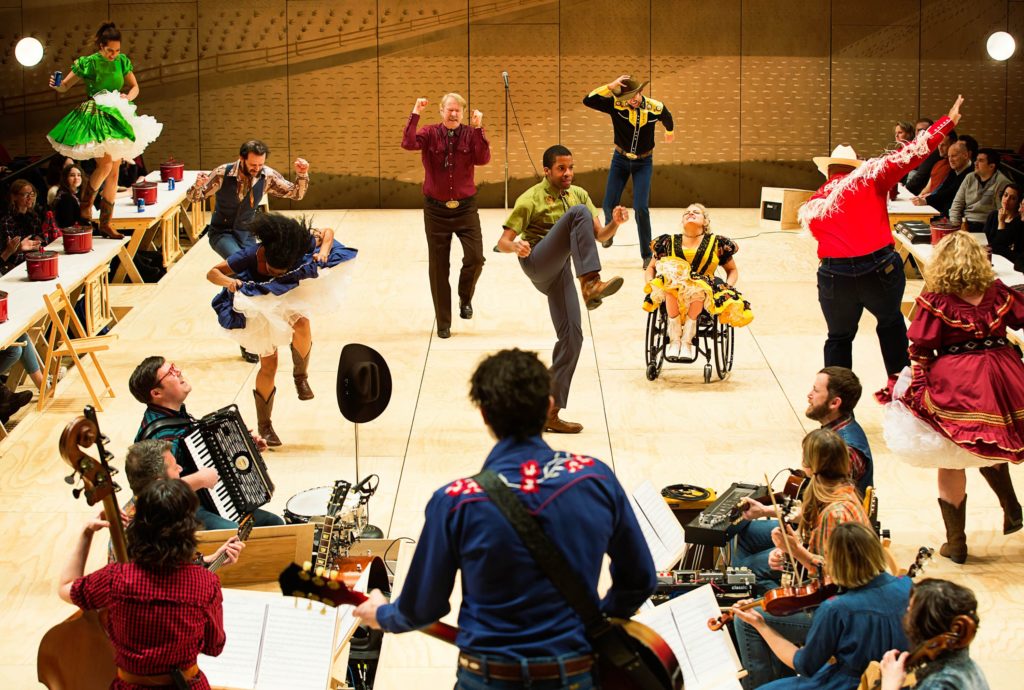
All these choices deliberately blur the distinction between actor and audience. At first, this creates a sense of community: we are all heading to the box social together. As the events of the second act take a sinister turn, being part of the community feels less fun. It starts to feel like we, the audience, are passive participants in something dark and cruel. It is less easy to leave the events of the story behind as you exit the theater.
Reframing racist caricature as itself a caricature
Even Rodgers and Hammerstein’s most ardent fans will usually acknowledge that some of the details of the duo’s work are…problematic. In “Carousel,” it’s the portrayal of domestic abuse; in “The King and I,” it’s the portrayal of race. In “Oklahoma,” it’s the character of Ali Hakim. He identifies, vaguely, as “Persian,” and is sometimes played by the sole actor of color in the company, with a thick, absurd accent.

In addition to having a racially diverse cast for all its characters, this “Oklahoma” finds a brilliantly simple way to circumvent the issue: Ali Hakim isn’t a “Persian”; he’s a lying huckster. Of course, Hakim has always been a lying huckster; the novel twist is that he’s lying specifically about his ethnicity. As played here – mercifully sans accent – he is, quite obviously, pretending at a racial identity in order to seem more “exotic.” (Actor Will Brill discusses the thinking behind his ingenious portrayal in this interview.)
Of course, that is essentially what Rodgers and Hammerstein were doing when they wrote the character: throwing in an exaggerated stereotype to add something “exotic” to their show. Other productions of “Oklahoma” have used Ali Hakim to try on the identity of another culture dishonestly, without affording it any respect or depth. In this production, Hakim himself is the one dishonestly trying on the identity, and the joke is solidly on him, rather than the audience. What used to be one of the ugliest aspects of “Oklahoma”’s storytelling becomes a new character detail that adds depth to a two-dimensional part of the story.
Consent is sexy; its absence is terrifying
This production of “Oklahoma” has acquired several nicknames: “Woke-lahoma,” “Oklaheauxma,” “Fucklahoma,” and – with elegant simplicity – “The Oklahoma That Fucks.”
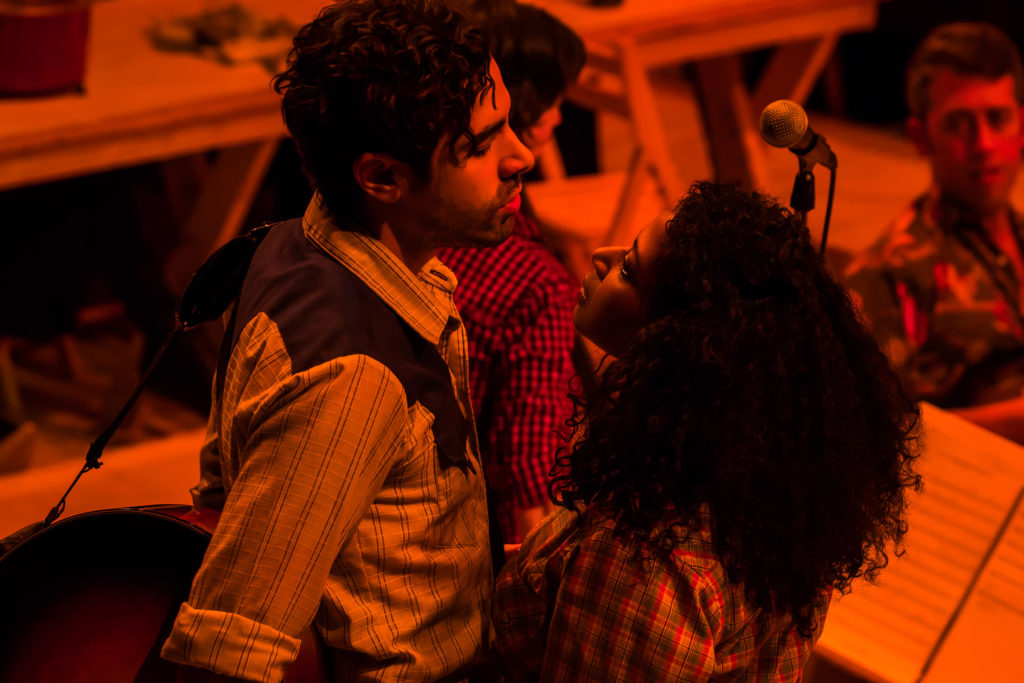
Typically, “Oklahoma” gives Laurey two options for suitors: affectionate, safe, sexless Curly, and erotic, dangerous, volatile Jud. The 1955 movie version of the musical contains a 14-minute dream ballet – a phrase that makes me bored and exhausted just to type – in which Laurey prepares to marry Curly, only for Jud to appear, murder Curly, and abduct her. The women depicted in the pornographic postcards in Jud’s room come to life, terrifying Laurey. Sex and violence are inextricably linked in her mind, and Jud personifies both.
This new “Oklahoma” reimagines the dream ballet entirely, muddying the waters of the Curly/Jud dichotomy. It also makes Curly’s sexual attraction to Laurey more obvious. (As Twitter user @whoiskatreally put it, “curly has never had this kind of sexual energy and boy am I here for it.”) In this light, Curly and Laurey’s antagonistic flirtation isn’t a hackneyed will they/won’t they. This isn’t “he teases you because he likes you.” Both characters are clearly afraid to admit the depth of their feeling because it’s dangerous and vulnerable. They’re never quite certain whether the full ardor of their passion is reciprocated.
Curly, especially, is cautious about this. Unlike Jud, he doesn’t want to coerce Laurey into tolerating his interest. He keeps giving Laurey opportunities to tell him “no” until he is certain she doesn’t want to. So, then, as my friend Margot brilliantly articulated it, this Curly is sexy because consent is sexy. Curly doesn’t just want Laurey, he wants Laurey to want him. As I less brilliantly articulated it, “Curly wants to give her the D so bad, but respectfully.”
This Jud, meanwhile, would feel right at home in the worst “red pill,” “men’s rights activists” corners of the internet. For the first several scenes, he simply sits on stage, drinking and watching the other characters with an aura of quiet menace. In my adult life, I have learned a deep-seated, intense fear of drunk men. I couldn’t even see Jud’s face from where I was seated, but I could tell that he was a living Chekhov’s gun, waiting to explode.
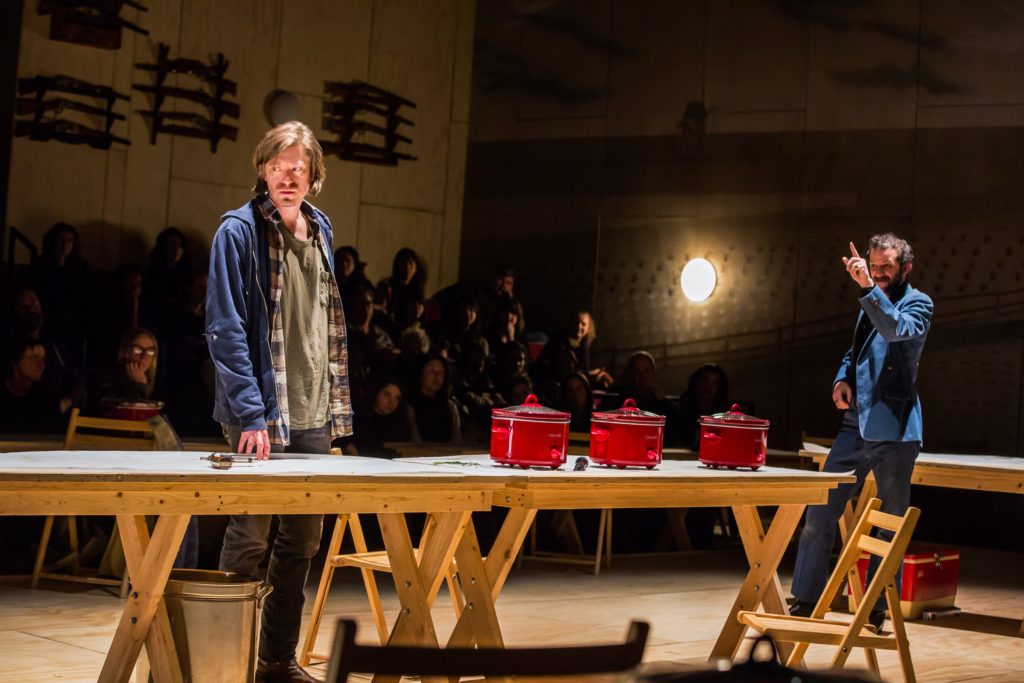
Jud is full of simmering resentment and immersed in pornography. (Neither of these details is a novel twist, and yet they feel so contemporary.) Both Laurey and the audience can sense that his interest in her isn’t grounded in any kind of respect for her autonomy or even any particular fondness for her personality. Jud’s sexuality isn’t inherently dangerous; it’s dangerous because it can’t be contained – not even by the word “no.”
One final accent on the theme of “sex can be fun, when you’re into it” is, of course, the character of Ado Annie. Ali Stroker, whose performance righteously earned her a Tony, brings all the reckless joy of lust to her performance. In particular, her character emphasizes the joy borne of mutual desire. She “cain’t say no” not because she’s not empowered to – she’s simply having too much fun to want to say no. Ado Annie’s lust is more spontaneous, less meaningful than Laurey’s – but both are treated as valid.
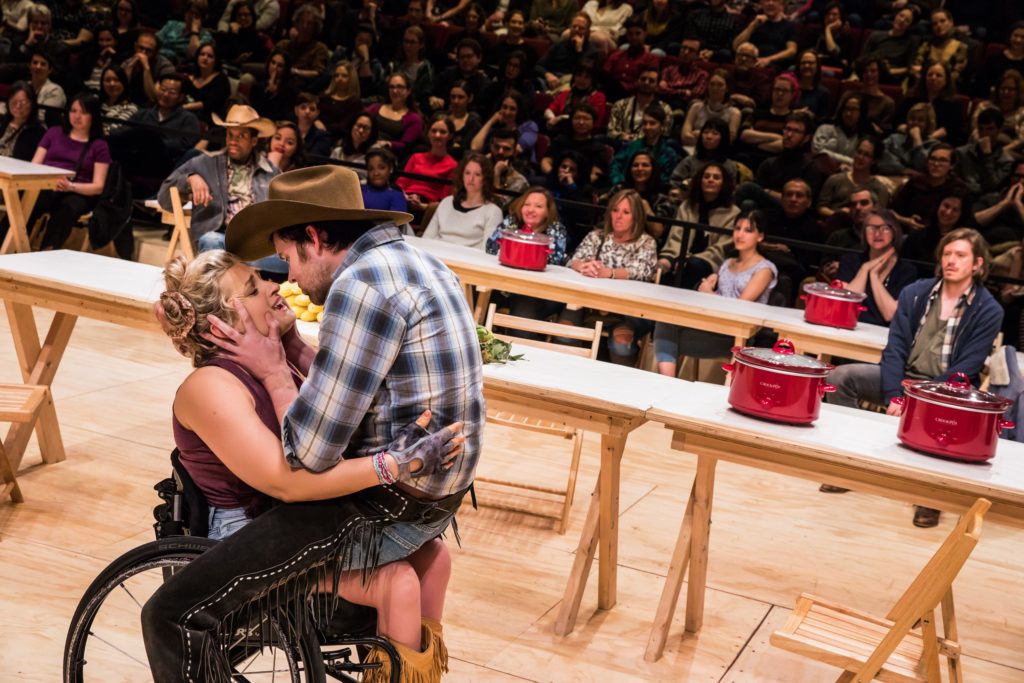
The terror of total darkness
Once in each act, all the lights in the theater go out, and the audience and the stage are together immersed in complete, unbroken darkness. In the second act, this happens when Jud has finally cornered Laurey alone, a moment she has been trying to avoid the entire show. We can’t see them, but we hear their voices: Jud reprimanding Laurey for avoiding him, Laurey fearfully denying it. We hear the sharp inhalation and tactile sounds as they kiss. Without any further clues, we have no idea if the kiss is consensual, although in the moments before Laurey sounds profoundly uncomfortable.
And then we hear the soft metallic sounds of Jud undoing his belt.
Even as the darkness frightened me – even as I was desperate to see what was happening onstage, and to know that Laurey was safe – I found myself grateful for the privacy it afforded me. Unlike during the rest of the show, no one could see my reactions, not even my friend who was seated next to me. I felt my face crumple into a look of unrestrained horror. I had no self-consciousness as I let the fear flow through me. I had no idea what would happen.
I reached out in the darkness to find my friend’s hand. We gripped each other tightly, painfully. “No, no no no,” she whispered, softly enough that only I could hear. The moment stretched on and on.
It was a rare moment in my life: I was given a space specifically to sit with my deepest fears, and examine them in privacy and safety. It was awful, and, yes, cathartic.
And then there’s that final scene
But before I can talk about it, I have to talk about the other moment of total darkness in the show, in the first act. Curly and Jud are alone when the lights go out, and again, we only hear their voices. But Jud isn’t the menacing one – it’s Curly. Sweet, affable Curly slyly tries to convince Jud to kill himself. He could play it off as a joke – but as you listen to them talk in the darkness, you know Curly isn’t joking at all.
Enough light comes on to illuminate Jud and Curly, seated so close to each other now that their faces nearly touch. A cameraman has appeared, shooting a tight close-up of Jud’s face, which is projected on the stage’s one wall in black and white. We see every emotion that crosses Jud’s face as Curly softly sings to him about how people will mourn Jud when he’s gone. In death, Curly promises, people will appreciate Jud more than they do now. They’ll discuss virtues of his that no one ever acknowledges now. (It’s unclear if Jud actually even has those virtues, or if this will be a case of someone who was mediocre in life being lionized in death.)
And so we come to the end of the show. After a three-week absence, Jud – the human Chekhov’s gun – appears at Curly and Laurey’s wedding. The air crackles with tension. Jud kisses Laurey and then presents Curly with a gift: a revolver. Slowly, he places the gun in Curly’s hand and points it at himself. Jud is giving Curly the choice: Kill Jud, or prove to him that Curly was telling the truth, and people do value Jud’s life and would mourn him when he’s gone. Give Jud a reason to keep living, or end his life.
After several seconds, Curly pulls the trigger, spattering himself and his new bride with blood. Jud slowly, slowly, lies down, as blood trickles down his shirt – although it’s not nearly as much blood as what covers Curly and Laurey’s faces. And we see for ourselves that Curly was lying, and no one cares that Jud is dead. The townspeople throw a hasty, perfunctory “trial” of Curly, where they quickly rule that he killed Jud out of self-defense. (In other productions, this is more straightforwardly true: Jud’s kiss with Laurey is more forceful, Jud is obviously drunk, and Jud attacks Curly. In the original production and the 1955 movie, Jud simply falls on his own knife in the ensuing struggle.)
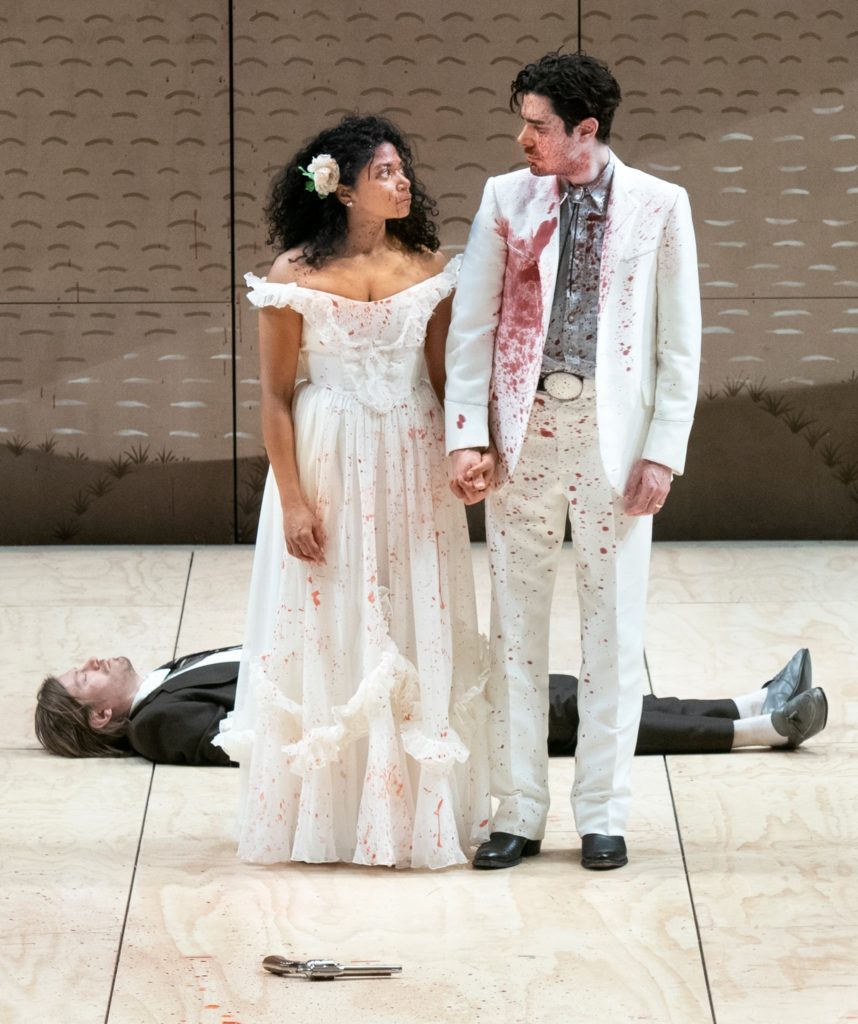
The cast – including the bloodstained newlyweds – sing the show’s titular song. They punctuate the lyrics with rhythmic stomping of their feet. Laurey channels all of her rage into pounding the ground beneath her with all her might. She hikes up her blood-spattered wedding dress and slams her boots into the stage. Nothing about the moment is celebratory. The audience – whose faces you can see clearly – is aghast.
Interrogating the author’s intent in a new light
Essentially, what I think director Daniel Fish did with this production of “Oklahoma” is say, “Alright, Rodgers and Hammerstein. What happens if I grant your underlying premise that women are commodities who go to the most deserving men?” (By the end of the show, every major male character but Jud is partnered up. Even Ali Hakim is forced to wed a minor character with an obnoxious laugh.) “What does that say about men who never wed? About women who take sexual pleasure as something of their own? About our culture as a whole?”
It necessarily follows that the result is menacing, frightening, and harrowingly relevant — without changing a word of the book or score.
Clearly, Rodgers and Hammerstein didn’t write “Oklahoma” as a story about toxic masculinity, or the pitfalls of insular societies, or the importance of female sexual consent. But when a piece of art holds at its heart ideas that are fundamentally true, it can take on a life of its own, especially when reinterpreted through fresh eyes. This is part of the magic of theater: without altering a word, a certain staging can make a text seem urgent and, somehow, new.
Thanks to my pal Margot for helping me flesh out the details of this post.
